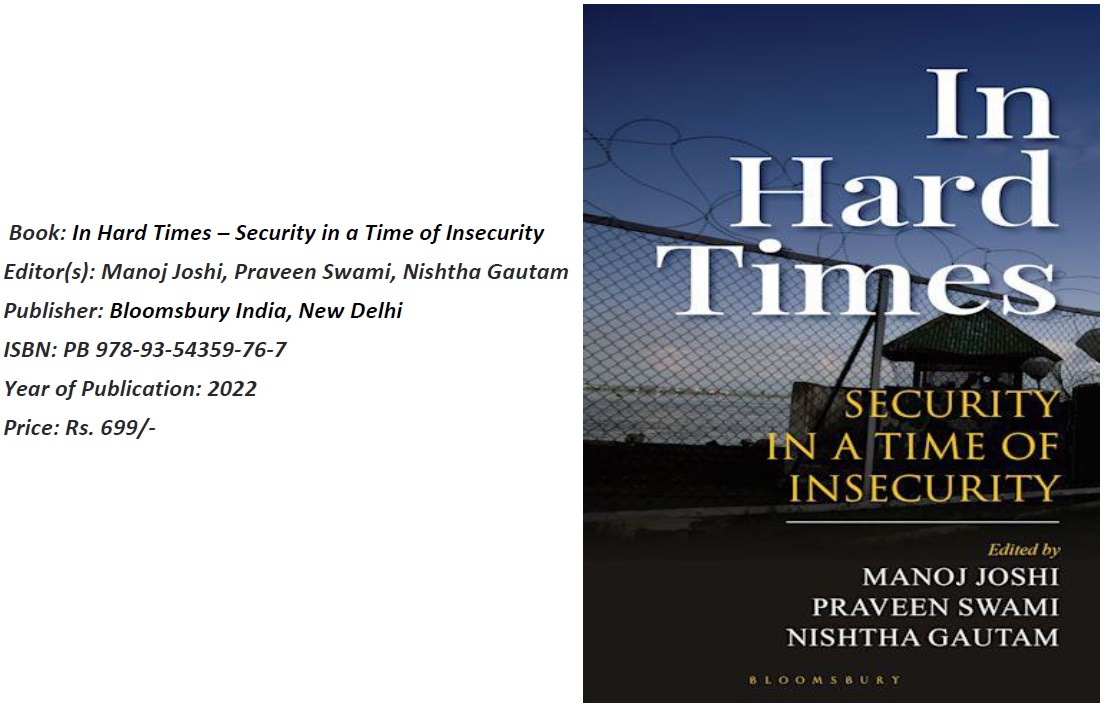
The book In Hard Times edited by well-known strategic writer Manoj Joshi and insightful journalists Praveen Swami, Nishtha Gautam delves into India’s national security aspirations particularly during and after mid-1990s. Since 1990s it was assumed that India would progress on a growth trajectory sufficient to modernise its security capacities and be on par with China. But reality has been otherwise. India needs a national security strategy for hard times which would be grounded in reality. India’s priority has to be the rising of vast numbers of its people out of abject poverty, even if the strategies of countries such as China and the United States of America, who are economically more developed nations can aim at being global powers.
Faced with an epoch – changing pandemic, an economy that had begun slowing down even before this catastrophic event and the distinct shifts in the power equations, the time has come to revisit the foundations on which the Indian national strategy has been built.
In Hard Times is an important anthology of essays that highlights the major challenges India confronts and discusses the ways they can be tackled. Its contributors include former military officers whose views have helped shape discussions on strategy as well as commentators. Nations often feel constrained by extent of geography with limited choices, but while geography may be fixed, geopolitics is an ever-changing affair in which the nation’s alignments are impermanent. Experience tells us that in war it is often the smarter side that wins not the stronger one. These essays seek to point out in that direction.
In this book we get a broad sense of India’s security sense in a time of great insecurity. They point towards the urgency of a fresh security strategy. Each essay seeks to approach the problems from a different perspective. Some of the essays are granular, ranging from proposing new, more efficient, means of warfighting and reforms in India’s intelligence and counter-insurgency architecture. Others focus on wider strategic picture, examining how India could better manage its strategic environment.
“The overall idea is to engender an informed public debate on the crisis that confronts India’s national security in the hope that such discussion will propel policymakers to begin serious discussion on way forward” states the introduction.
In the first chapter, Dr Sanjaya Baru surveys India’s strategic landscape as it emerges from the Covid – 19 pandemic and argues for a medium-term re-appraisal of India’s strategic ambitions. He makes a strong case for India to not only defend multilateralism but also create space for its own growth and development. In the next chapter, Pranay Kotasthane provides analysis of the pressures of India’s defence expenditures and the impacts these have on military modernisation.
The six subsequent chapters debate how the armed forces might evolve and grow in a resource constrained environment. Admiral Arun Prakash makes the case for looking beyond the naval power alone and paying greater attention to India’s overall maritime capabilities. Lt. General D.S. Hooda argues for deep human resource reforms to free up resources for modernisation. Adoption of technology will help reduce manpower costs and can be balanced by increasing use of robotics, AI, UAVs etc. Air Vice Marshal Manmohan Bahadur reflects on doctrinal changes needed to rethink how India’s airpower capabilities might best be grown in challenging times. He observes that India’s defence budget is inadequate to maintain combat effectiveness. Col. Vivek Chadha and Group Captain Kishore Kumar Khera offer alternatives perspectives on military challenge. An expansive role for India’s military beyond its neighbourhood in the Indo-Pacific region calls for developing substantial maritime and airpower capabilities. Nishtha Gautam makes the case for gender to be placed at the centre of Indian military debates, pointing to advantages of greater representation of women in the armed forces.
In next two chapters, Praveen Swamy considers how India’s way of counterinsurgency and intelligence could be rethought to address the challenges. The chapters point out to deficits of capacity and make the case for reforms. In the afterword, Manoj Joshi sums up the debates raised in the book and reviews challenges that lie ahead.
The book deals with the here and now and the chapters provide a sum that is greater than its parts. The book examines the issue of national security in the narrow frame of our time. We are living in an era of change. The existing template of security in India needs urgent reform. The authors have examined various facets, sifted through the data carefully, offered critiques, come up with practical suggestions that could help turning things around. They have sought to craft solutions that require purposefulness and teamwork and get the nation to bite the bullet.
India needs to prudently manage its national security. The need of the hour is a ‘whole-of-the-nation’ approach that inculcates a sense of harmony, calm and modesty, which works towards putting the economy on a higher growth trajectory. The book also highlights that national security is inextricably linked to economic development and internal harmony.
Contributors to this book have not hesitated to call a spade a spade. The book highlights important points like the resources crunch for our defence needs. There are new challenges for our maritime security. Our intelligence apparatus needs overhaul. The book is timely, since India is situated in one of the most troubled regions in the world and the discussion and clarity on issues of national security are vital.


